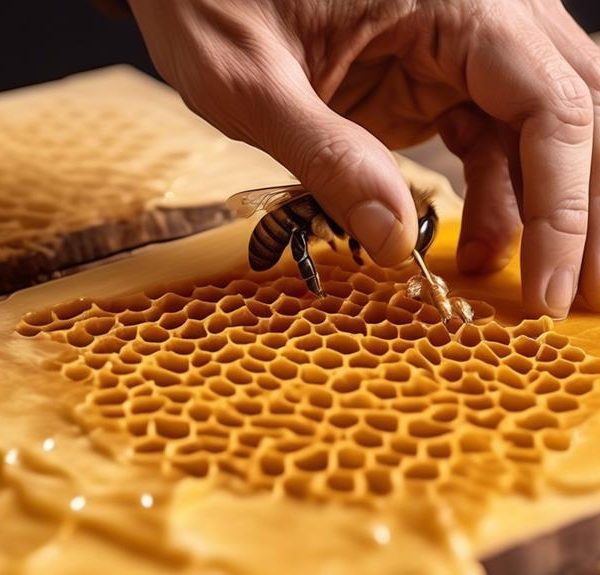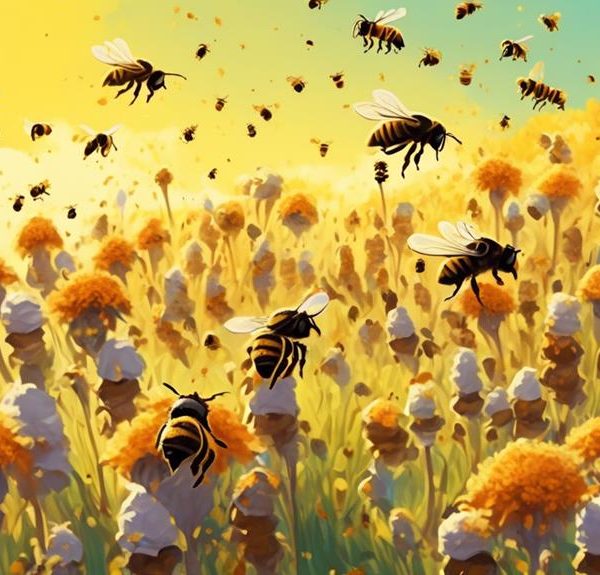Navigate the buzzing world of bees and uncover whether these vital pollinators can actually hear human conversations.

Can Bees Hear Humans?
You've probably never lain awake at night, pondering the monumental question, 'Can bees hear me?' But, in the vast world of nature's unsolved mysteries, this one might just top the list.
As you stroll through the park, you can't help but wonder if those buzzing insects are picking up on your conversations or if you're just background noise in their busy lives. It's a question that's not only interesting but might also have profound implications for our understanding of these vital pollinators.
So, are you ready to dive into the buzzing cacophony and uncover what science has to say about this?
Key Takeaways
- Bees have a unique form of 'hearing' through sensing vibrations, rather than perceiving sound like humans.
- Bees can 'hear' airborne sounds up to 500 Hz, but their sensitivity decreases for sounds above this frequency.
- Human-made noises within the bees' frequency range could elicit a response from bees.
- Understanding bee perception of sound is important for bee conservation, as human noise pollution can disrupt their communication and navigation.
Understanding Bee Sensory Perception
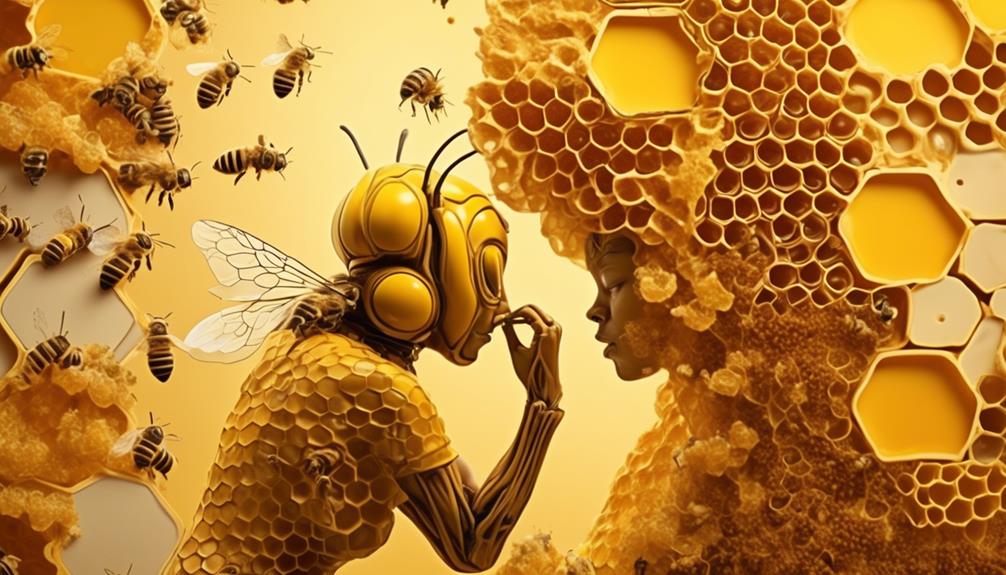
While you might think bees are simple creatures, their sensory perception is surprisingly complex and versatile, allowing them to navigate their environment effectively. Bees possess a compound eye system composed of thousands of tiny hexagonal lenses, each one capturing a pixel of light. This system enables them to detect polarized light, a capability beyond human vision. It's a vital tool for navigation, particularly when the sun is obscured.
Furthermore, bees don't rely on hearing as we do. Instead, they communicate through vibrations and pheromones. Their antennae contain Johnston's organ, a sensory organ that detects these vibrations. When a bee performs the waggle dance, it's not just a quirky behavior; it's a sophisticated method of communication, relaying precise information about the location of food sources.
On the olfactory front, bees have a keen sense of smell, which they use to identify different types of flowers, detect danger, and recognize hive mates. Their antennae serve as their noses, containing receptors that can detect a wide array of chemical compounds.
The Science of Bee Communication

Delving into the science of bee communication, you'll find an intricate system of vibrations, pheromones, and dances that transcends human understanding. Bees don't hear as we do; rather, they perceive vibrations through Johnston's organ, located in their antennae. This sensory organ converts vibrational signals into electrical impulses, allowing bees to decode complex messages within their colony.
Understanding the role of pheromones in bee communication requires a deep dive into chemical ecology. Essentially, bees release specific pheromones to alert others in the hive to danger, food sources, and swarm plans. These volatile chemicals, each carrying a unique message, are detected by bees' well-developed antennal receptors. Remarkably, a single pheromone can trigger an immediate, coordinated response from the entire hive.
Lastly, you'll be fascinated by the bees' waggle dance, a unique form of communication discovered by Karl von Frisch. This rhythmic movement encodes vital information about food source direction and distance. Performed within the hive, the dance's tempo, duration, and orientation translate to specific geographic coordinates. It's a testament to the extraordinary complexity of bee communication, a system that operates effectively without the need for audible human-like sounds.
Bees and Human Sound Interaction
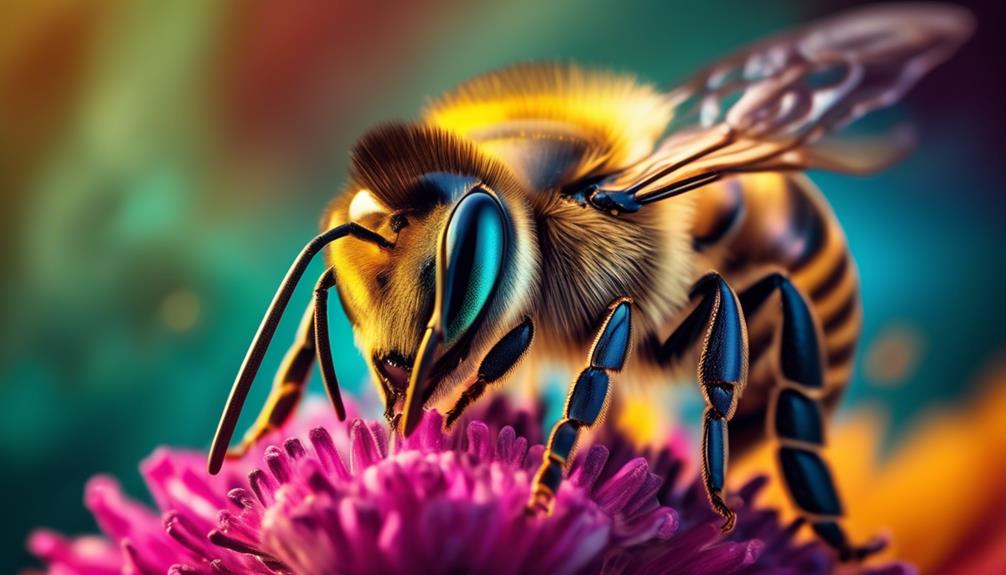
You might wonder if bees, with their unique communication system, can interpret or respond to human sounds in any way. The short answer isn't exactly. Bees don't perceive sound like humans do. They don't have ears; instead, they sense vibrations through their bodies. However, this doesn't mean they can't interact with human-produced sounds.
Research suggests that bees may respond to certain vibrations and frequencies, akin to how we respond to sounds. For instance, bees can detect the buzzing of fellow hive members or predators, which triggers defensive or foraging behaviors. It's possible that certain human-made noises, particularly those within the bees' frequency range, could elicit a similar response.
However, there's no evidence to suggest that bees understand the complexities of human speech or music. They're not processing these sounds in a way that has meaning to them, like recognizing a threat or a source of food. It's more about the physical properties of the sound waves and how they resonate within the bees' bodies.
Research Findings on Bee Hearing
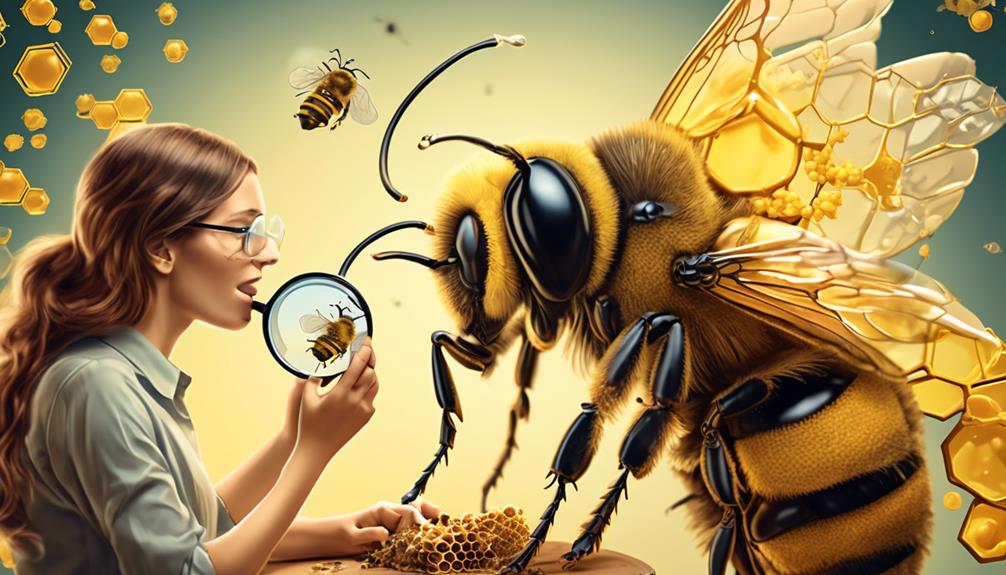
In light of recent studies, it's been discovered that bees may have a unique form of 'hearing' through their ability to sense vibrations. This means, in essence, bees perceive sounds in a different way than you do.
Through precise experiments, scientists have observed that bees respond to vibrations transmitted through the air and substrate. These vibrations are picked up by the Johnston's organ, a sensory structure located in their antennae. This organ is highly sensitive to frequency and amplitude changes, allowing bees to distinguish between different types of vibrations.
Furthermore, studies have shown that bees can 'hear' airborne sounds at frequencies up to 500 Hz. However, their sensitivity decreases for sounds above this frequency. This aligns with the typical frequency range of buzzing sounds produced by their own wings and those of other insects.
These findings are significant as they suggest a remarkable adaptation in bees, allowing them to communicate and navigate their environment. So, while it's not 'hearing' as you understand it, bees do possess an intricate sensory ability to 'listen' to the world around them.
This research opens up new avenues for understanding and protecting these vital pollinators.
Implications for Bee Conservation

Given these intriguing findings on bee 'hearing', we can begin to explore their implications for bee conservation strategies. Understanding how bees perceive sound could prove essential in developing more effective measures to protect these vital pollinators.
Bee populations have been declining globally, putting food production at risk due to their crucial role in pollination. If bees use sound to communicate or navigate, human noise pollution could be disrupting these activities, contributing to their decline.
Knowing this, you can refine conservation strategies. For instance, creating 'quiet zones' around bee habitats might be an effective mitigation measure. Further research could explore how different sound frequencies impact bees and which sounds are most disruptive.
In addition, understanding bees' auditory capabilities could improve beekeeping practices. Beekeepers might adjust their techniques to minimize disturbance, such as using quieter equipment or modifying their approach to hive management.
However, it's important to remember that sound is likely just one factor affecting bee populations. Pesticide exposure, habitat loss, and climate change are also pressing issues. Still, every piece of information helps to build a more comprehensive picture of what bees need to thrive.
Frequently Asked Questions
What Is the Lifespan of a Typical Bee?
You're curious about a bee's lifespan, aren't you?
Typically, a worker bee's life lasts 6 weeks during summer, while drones live until they mate or for 90 days. The queen bee, however, can live up to 5 years.
Factors such as species, role in the hive, and environmental conditions can influence their lifespan. It's fascinating to comprehend the wide range of lifespans within a single bee colony, isn't it?
How Can Humans Contribute to the Preservation of Bee Populations?
You can contribute to preserving bee populations in several ways.
- Planting bee-friendly flowers in your garden provides them with necessary food sources.
- Avoid using pesticides, as they're harmful to bees.
- Creating a small water basin in your yard helps hydrate bees.
- Buying local honey supports your local beekeepers.
- Moreover, spreading awareness about the importance of bees can have a significant impact.
Are There Any Other Animals That Communicate in a Similar Way to Bees?
Yes, there are other animals that communicate similarly to bees.
For instance, dolphins use a complex system of clicks, whistles, and body movements.
Ants also use pheromones and touch to relay information.
These communication methods, like bees' dance language, are intricate and serve vital roles in these species' survival.
Understanding these systems can deepen your appreciation for the sophistication of animal communication.
How Does the Bee's Hearing Ability Compare to Other Insects?
You're likely wondering how a bee's hearing ability stacks up against other insects.
Bees don't have ears like humans, but they can pick up sounds through Johnston's organs in their antennae.
Compared to some insects like crickets, who use tympanal organs, bees' hearing isn't as advanced.
They're more attuned to vibrations than actual sounds.
What Is the Role of Queen Bees in the Bee Colony's Communication System?
As the queen bee, you're vital in your colony's communication system. You produce pheromones that control the behavior and development of your colony. These chemicals signal your workers about your presence and fertility. They affect their duties, suppress their egg-laying, and even guide them to you.
Conclusion
So, can bees hear you? Not in the way you might think.
Bees don't have ears, but they do perceive vibrations, which is a form of sound perception. Scientific studies show they can even communicate using vibrational signals.
This doesn't mean they understand human speech, but it does highlight how diverse and intricate their sensory world is.
Understanding this is crucial to preserving these vital pollinators in our rapidly changing world.

